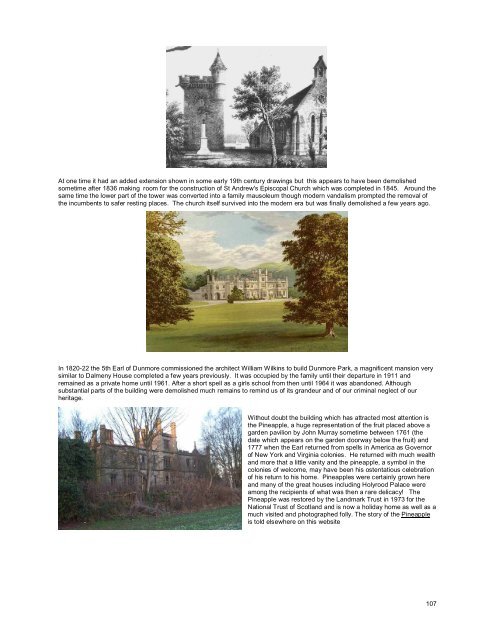Grand Masters of Scotland - Onondaga and Oswego Masonic ...
Grand Masters of Scotland - Onondaga and Oswego Masonic ...
Grand Masters of Scotland - Onondaga and Oswego Masonic ...
You also want an ePaper? Increase the reach of your titles
YUMPU automatically turns print PDFs into web optimized ePapers that Google loves.
At one time it had an added extension shown in some early 19th century drawings but this appears to have been demolished<br />
sometime after 1836 making room for the construction <strong>of</strong> St Andrew's Episcopal Church which was completed in 1845. Around the<br />
same time the lower part <strong>of</strong> the tower was converted into a family mausoleum though modern v<strong>and</strong>alism prompted the removal <strong>of</strong><br />
the incumbents to safer resting places. The church itself survived into the modern era but was finally demolished a few years ago.<br />
In 1820-22 the 5th Earl <strong>of</strong> Dunmore commissioned the architect William Wilkins to build Dunmore Park, a magnificent mansion very<br />
similar to Dalmeny House completed a few years previously. It was occupied by the family until their departure in 1911 <strong>and</strong><br />
remained as a private home until 1961. After a short spell as a girls school from then until 1964 it was ab<strong>and</strong>oned. Although<br />
substantial parts <strong>of</strong> the building were demolished much remains to remind us <strong>of</strong> its gr<strong>and</strong>eur <strong>and</strong> <strong>of</strong> our criminal neglect <strong>of</strong> our<br />
heritage.<br />
Without doubt the building which has attracted most attention is<br />
the Pineapple, a huge representation <strong>of</strong> the fruit placed above a<br />
garden pavilion by John Murray sometime between 1761 (the<br />
date which appears on the garden doorway below the fruit) <strong>and</strong><br />
1777 when the Earl returned from spells in America as Governor<br />
<strong>of</strong> New York <strong>and</strong> Virginia colonies. He returned with much wealth<br />
<strong>and</strong> more that a little vanity <strong>and</strong> the pineapple, a symbol in the<br />
colonies <strong>of</strong> welcome, may have been his ostentatious celebration<br />
<strong>of</strong> his return to his home. Pineapples were certainly grown here<br />
<strong>and</strong> many <strong>of</strong> the great houses including Holyrood Palace were<br />
among the recipients <strong>of</strong> what was then a rare delicacy! The<br />
Pineapple was restored by the L<strong>and</strong>mark Trust in 1973 for the<br />
National Trust <strong>of</strong> <strong>Scotl<strong>and</strong></strong> <strong>and</strong> is now a holiday home as well as a<br />
much visited <strong>and</strong> photographed folly. The story <strong>of</strong> the Pineapple<br />
is told elsewhere on this website<br />
107







![Richard [Nicholls] Harison / Harrison - Onondaga and Oswego ...](https://img.yumpu.com/24950065/1/190x245/richard-nicholls-harison-harrison-onondaga-and-oswego-.jpg?quality=85)
![Richard [Nicholls] Harison / Harrison - Onondaga and Oswego ...](https://img.yumpu.com/24950063/1/190x245/richard-nicholls-harison-harrison-onondaga-and-oswego-.jpg?quality=85)








